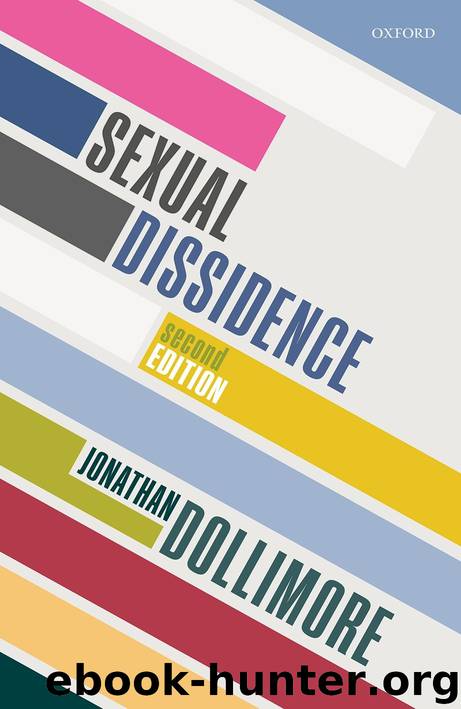Sexual Dissidence by Jonathan Dollimore

Author:Jonathan Dollimore
Language: eng
Format: epub
ISBN: 9780192561916
Publisher: OUP Oxford
Published: 2018-07-23T16:00:00+00:00
1 See especially Lewes’s detailed recent history, The Psychoanalytic Theory of Male Homosexuality.
2 Writing in 1948, Kinsey and others pointed out that previous so-called ‘scientific’ classifications of perversions by the pioneer sexologists ‘have been nearly identical with theologic classifications and with the moral pronouncements of the English common law of the fifteenth century. This, in turn, as far as sex is concerned, was based on the medieval ecclesiastical law which was only a minor variant of the tenets of ancient Greek and Roman cults, and of the Talmudic law’ (Kinsey et al., Sexual Behavior, 202; see also Weeks, Sexuality, 70).
3 One way the metaphysic survives in a modern mutation is in the description of the homosexual as ‘bent’, and the heterosexual as ‘straight’; the OED gives as one meaning of ‘bent’: ‘perverted; spec. homosexual’, and cites a passage from Maclnnes’s Absolute Beginners (1959).
4 Normative conceptions of human nature persist even in a radical psychoanalysis. Yiannis Gabriel has argued this in relation to the work of two Freudian radicals, Wilhelm Reich and Erich Fromm. Though differently, each advanced the view that ‘human emancipation requires only [!] a revolution in the social base and superstructure and in the psychic superstructure’; it need not touch the all important ‘psychic base’, the source of an essential goodness and revolutionary potential in human nature. Thus argues Gabriel; both Reich and Fromm posit ‘a human core in each individual, which is totally unpolluted by society; human nature is discovered in the profound depths of the individual’s soul’, itself untouched by society (see Freud and Society, 191).
5 Just one indication of this disregard is the virtual absence of an account of the perversions in the obligatory summaries of Freud which preface the use of psychoanalysis within literary and cultural theory (see, for example, Eagleton’s Literary Theory). This may be related to the fact that, as Leo Bersani suggests, the complexity and obscurity of some recent returns to Freud—e.g. Lacan’s—have perhaps given an intellectual respectability to Freud while leaving intact some of the more conservative elements of Freud’s work—e.g. his phallocentrism, the category of neurosis, and a normative notion of psychosexual development (The Freudian Body, 2). As regards the perverse there are exceptions, suggestive rather than developed, but useful nevertheless. For example, Brooks in ‘The Idea of a Psychoanalytic Criticism’ (pp. 7–8) suggests, following Roland Barthes in S/Z that ‘the work of textuality may ensure that all literature is, by its very nature, essentially perverse’.
6 At one stage Freud distinguished the two; later he made the distinction less sharply, and then in Introductory Lectures (1915–17) homosexuality was included again in the class of perversions. (See xv. 222, where he declares that homosexuality is the most important of the perversions and so much so that it scarcely deserves the name.) These shifts perhaps reveal both Freud’s sense of the significance of homosexuality and his residual sense of the perversions as intrinsically rather than contingently pathological. Lewes suggests that Freud maintained the distinction between homosexuality and perversion (The Psychoanalytic Theory of Male Homosexuality, 29–30).
Download
This site does not store any files on its server. We only index and link to content provided by other sites. Please contact the content providers to delete copyright contents if any and email us, we'll remove relevant links or contents immediately.
| African-American Studies | Asian American Studies |
| Disabled | Ethnic Studies |
| Hispanic American Studies | LGBT |
| Minority Studies | Native American Studies |
Cecilia; Or, Memoirs of an Heiress — Volume 1 by Fanny Burney(31447)
Cecilia; Or, Memoirs of an Heiress — Volume 3 by Fanny Burney(31037)
Cecilia; Or, Memoirs of an Heiress — Volume 2 by Fanny Burney(30985)
The Great Music City by Andrea Baker(23036)
We're Going to Need More Wine by Gabrielle Union(18127)
Bombshells: Glamour Girls of a Lifetime by Sullivan Steve(13159)
Pimp by Iceberg Slim(13000)
All the Missing Girls by Megan Miranda(12841)
Fifty Shades Freed by E L James(12492)
Talking to Strangers by Malcolm Gladwell(11991)
Norse Mythology by Gaiman Neil(11964)
Crazy Rich Asians by Kevin Kwan(8413)
Mindhunter: Inside the FBI's Elite Serial Crime Unit by John E. Douglas & Mark Olshaker(7901)
The Lost Art of Listening by Michael P. Nichols(6534)
Enlightenment Now: The Case for Reason, Science, Humanism, and Progress by Steven Pinker(6449)
Bad Blood by John Carreyrou(5816)
The Four Agreements by Don Miguel Ruiz(5578)
Weapons of Math Destruction by Cathy O'Neil(5098)
We Need to Talk by Celeste Headlee(4922)
